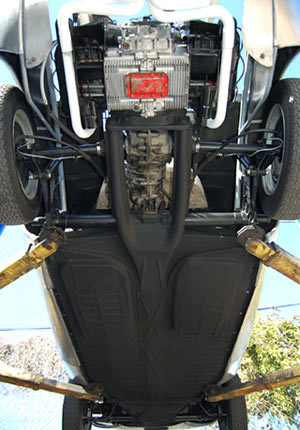In the rarefied realm of vintage road-and-track machines, alloy-bodied Specials created during the early post-WW II era occupy a unique place; accordingly, the few surviving examples are highly regarded by well-heeled collectors all over the World.
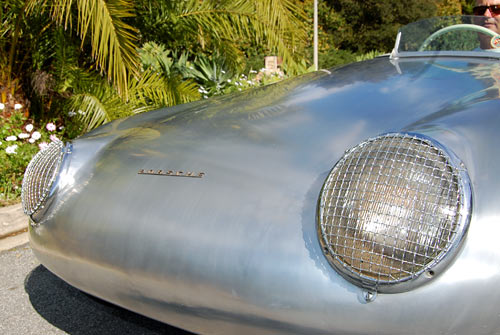
Click on the above image for an XXL-sized view (a separate browser window will open)
In war-ravaged Europe, combining a small engine with a lightweight chassis and an aerodynamic body was the ultimate goal of Professor Ferdinand Porsche. His Modell 356 sports car was based on Der Führer's Volkswagen, and was initially built in very small numbers, beginning in 1948.
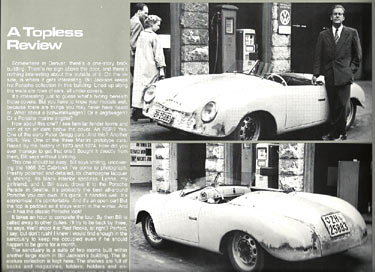
|
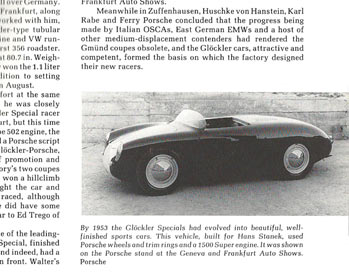
|
Click on any of the above images for a full-size view
Porsche was not the only one to embrace the Volkswagen theme. Fellow Germans Walter Gloeckler and PeterMax Mueller designed significant and very successful VW-based race cars of their own, built as one-offs with small budgets and Nazi-era parts.
Similarly, talented young Americans settling in California after wartime service paired pre-war chassis with new, lightweight bodywork and hopped-up mills to create amazingly fast American Specials. Names like Edwards, Troutman-Barnes, Baldwin, and Ak Miller instantly come to mind.
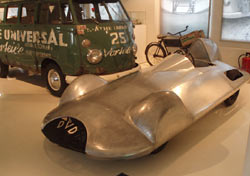
|
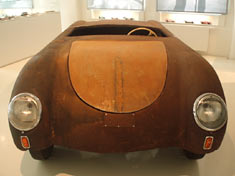
|
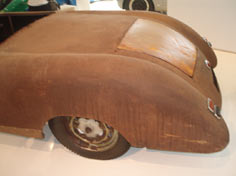
|
Click on any of the above images for a full-size view
Since these early attempts at going fast on a budget were soon relegated to the scrap heap by bigger and stronger, factory-built race cars and the advent of lightweight fiberglass materials, very few examples showcasing the virtually lost art of metal shaping have survived, some being rescued and displayed, unrestored, in esoteric collections such as the 'Prototyp Museum' in Hamburg, Germany or the 'Flying Pig Speed Shop' in Connecticut.
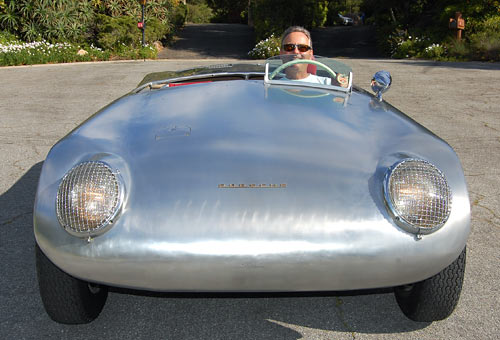
Click on the above image for an XXL-sized view (a separate browser window will open)
The 1953 Spyder presented here, clothed in a slippery, hand-formed aluminum skin, combines German mechanicals with American metalworking skills. It certainly is one of the most exciting barn finds to emerge from its dusty confines in decades. And, yes, it really was stored in a barn!
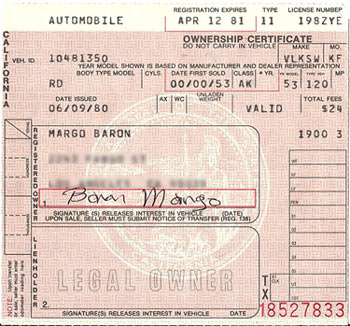
|
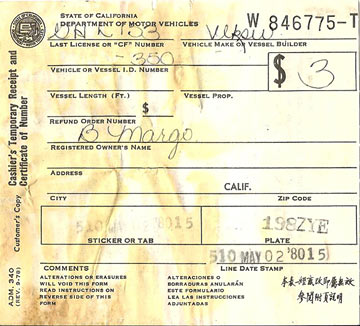
|
Click on any of the above images for a full-size view
For more than 30 years, this fantastic one-off was owned by eccentric Los Angeles-based sculptor and collector Baron Margo, long-time aficionado of alloy-bodied cars. It comes with its small California pink slip and blue-and-yellow license plates 198 ZYE, affixed back in 1980. Prior, the car wore black-and-yellow California plates GHN 153, as evidenced by the old registration application shown on the right.
(A bit of license plate trivia: the combination starting with the letter "G" marks it as a plate that was handed out to used vehicles in 1963, when the old 1956-'62 tags had to be exchanged for the new black plates - thus, we can safely surmise that the car had been originally registered in California before 1963.)
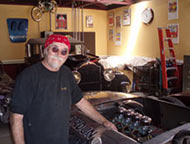
|
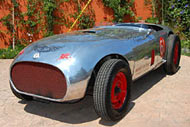
|
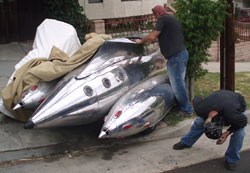
|
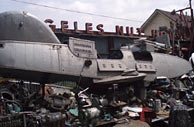
|
Click on any of the above images for a full-size view
Our acquaintance with the gregarious Baron stems from another transaction, a few years ago, when we were able to wrest the behemoth shown in the pictures above (on the left) away from him. We knew that the car was "the real deal" because the Baron had owned it since the early 1970s, but could not find any corroborating history until a few months after we sold it. Amazingly, a few vintage photos were posted online by the son of the car's former driver, and it turned out to be one of four known Specials built in the late 1940s by Willis Baldwin of Santa Barbara. Being a direct inspiration for the Troutman-Barnes car, this alloy-bodied Baldwin Special has since been restored and was appraised at $525,000.00!
We knew the Baron had squirreled away another vintage alloy roadster, decades ago; when he was finally ready to let go, we returned to the Los Angeles Nut House (nickname of the Baron's Echo Park Hills studio) to take a look.

Click on the above image for an enhanced view of the Spyder, buried in the lower right corner.
Yes, some early L.A. residences feature barns in the backyard, and the Baron's place is one of those. It was a sunny California summer day, and our eyes needed a few minutes to adapt to the barn's twilight. Entombed like a mummy inside a dusky pyramid, protected from the elements and the prying eyes of automobile archeologists, the Spyder shared its space with a super rare, pre-war Boles travel trailer, a Porsche 356A Speedster--which has since been sold--and a 1948 Jaguar MK IV Convertible, which has not seen the light of day since 1966, when the Baron rolled it into the barn, covering it with a tarp!
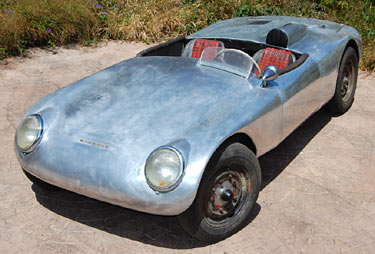
|
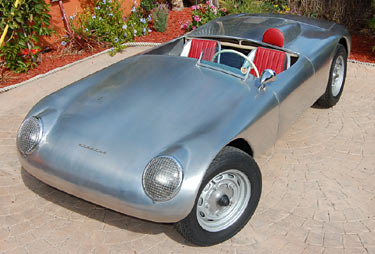
|
Click on any of the above images for a full-size view
It took considerable manpower to free the Spyder from its dark prison; when it finally arrived home, we were delighted by its completeness and overall excellent state of preservation. Mind you, this car is more than half a century old! We embarked on a sympathetic restoration, aiming to keep as much of the irreplaceable patina intact as possible. Looking at the "before and after" pictures above, I'd say we've succeeded.
Let's inspect this unique Spyder in great detail now, inside and out.
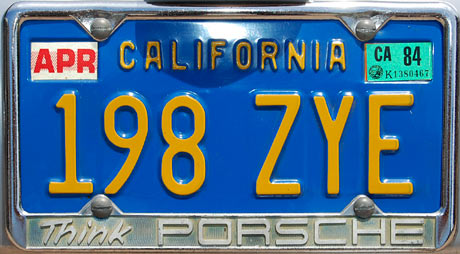
The famous, blue-and-gold California license plate.
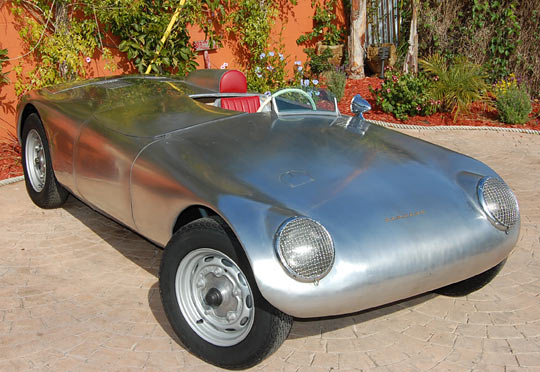
Click on the above image for an XXL-sized view (a separate browser window will open)
According to the Baron, the Spyder was originally built to participate in the Mexican "Carrera Panamericana" road race of 1955, however, the event was abruptly cancelled after the tragic Le Mans accident. Instead, the car was street-driven for a few years and finally parked in a Hollywood garage, where the Baron discovered it sometime during the mid-1970s.
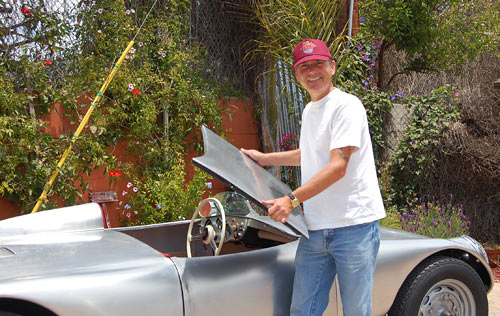
Click on the above image for an XXL-sized view (a separate browser window will open)
To maximize streamlining during a race, Spyder features a flush-fitting alloy cockpit cover, which can be removed in seconds, turning the car into a comfortable two-seater.
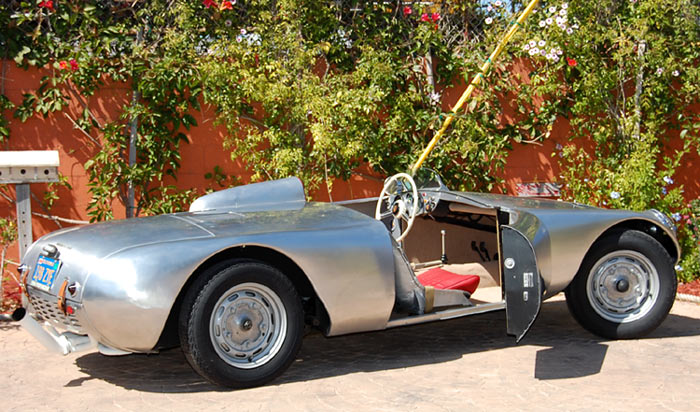
Click on the above image for an XXL-sized view (a separate browser window will open)
Miraculously, the Spyder's Superleggera-style coachwork, a round-tube 'skeleton' frame covered by hand-formed aluminum, survived intact for all these years. You'd have to see it in person to really appreciate the superb workmanship. Clearly, this car was built by professionals; some research suggests San Fernando Valley's long-defunct Kar Kraft facility as creator of this marvelous custom body.
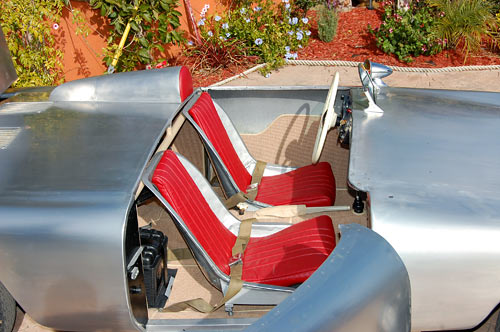
Click on the above image for an XXL-sized view (a separate browser window will open)
The upholstery, though complete, had deteriorated due to its age and was replaced with authentic materials.
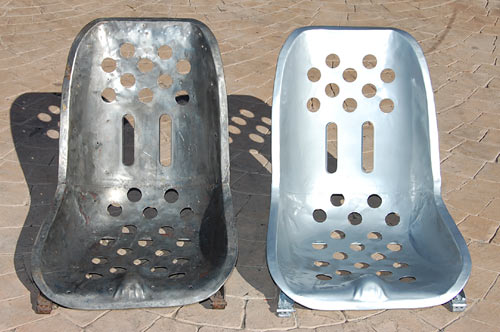
Click on the above image for an XXL-sized view (a separate browser window will open)
Pure Unobtainium: the 1950s Porsche Spyder all-steel seats! We've had the seat cover design replicated, choosing the correct, brick red 550 Rennspyder vinyl, to stunning effect.
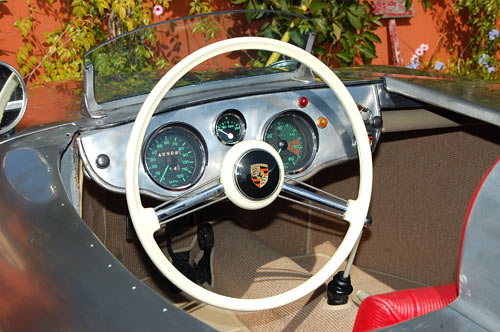
Click on the above image for an XXL-sized view (a separate browser window will open)
Simple--but fully functional--dash houses the original, unrestored Porsche Pre-A gauges and switchgear that seems to have originated from a VW Schwimmwagen or KDF Ur-Beetle!
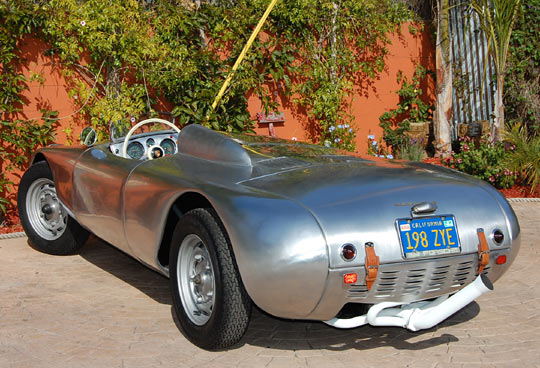
Click on the above image for an XXL-sized view (a separate browser window will open)
Aerodynamic head rest for the driver was a must have during the early-to-mid 1950s era.
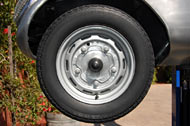
|
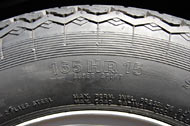
|
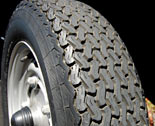
|
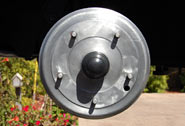
|
Early KPZ ("Kronprinz") Porsche wheels all around were fitted with a set of N.O.S., date-coded SEMPERIT 165 HR 15 "Super Sport" High Speed tires. Note Porsche 356 alloy brake drums. The brake system was completely gone through, including new flexible lines, new master cylinder, rebuilt wheel cylinders, and reconditioned linings.
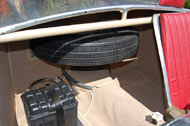
|
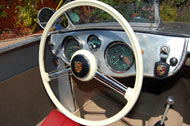
|
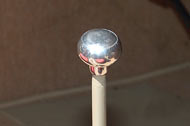
|
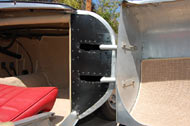
|
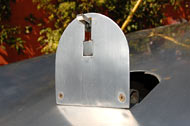
|
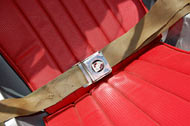
|
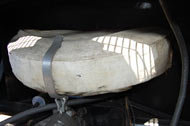
|
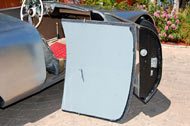
|
Click on any of the above images for a full-size view
Photos above show amazing attention to the smallest detail. Clockwise, from top left:
- Roomy luggage compartment. Note German Haargarn square weave carpeting, 6-Volt battery, location of spare tire.
- Restored Pre-A Speedster wheel. Hooded Pre-A gauges. Old leather key fob. Black bakelite starter button.
- Unusual, polished alloy shift knob.
- Superfluous on the low, open Spyder, but demanded by the competition rulebook: a functional door -- it's beautifully finished!
- The aluminum half-tonneau, removed by the simple turn of a handle, displays superior craftsmanship.
- Spare protrudes into engine bay. Original protective cover was hand-stitched from heavy oil cloth.
- Period Porsche lap belts with chrome buckles.
- Quick-release fuel filler door.
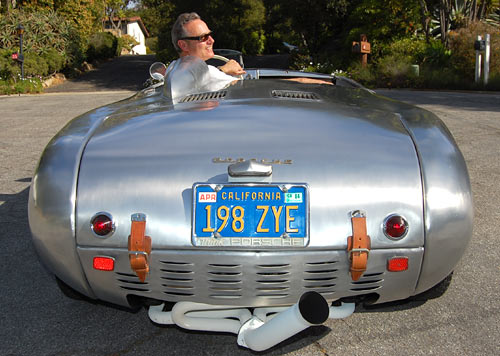
Click on the above image for an XXL-sized view (a separate browser window will open)
Ancient BOSCH 6-Volt headlights (with fluted lenses and stone guards), beehive taillights, brake lights, high beams, and horn work flawlessly, as do all the gauges, including the rare mechanical tach. Deck lid is secured by leather buckles.
Ach Du Lieber, where is Der Motor?
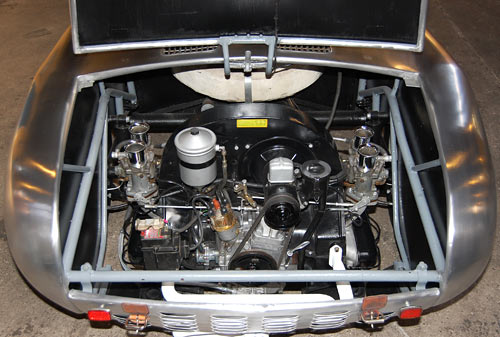
Click on the above image for an XXL-sized view (a separate browser window will open)
Birdcage-like tube structure is visible throughout the engine bay, giving it an "all business" look. Power plant features a genuine Porsche 356 Super 90 pushrod case (# 616/7), presumably installed after the original 1500cc roller bearing power plant expired. The motor was carefully revived after the long hibernation by Helmut Haupt and just recently serviced at our favorite Porsche specialist garage, TLG in North Hollywood. Consequently, it runs super strong and sounds even better, developing about 100 lively horses, more than enough to propel the lightweight Spyder into the fun zone and beyond!
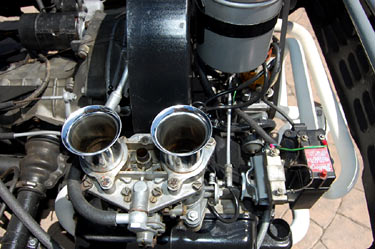
|
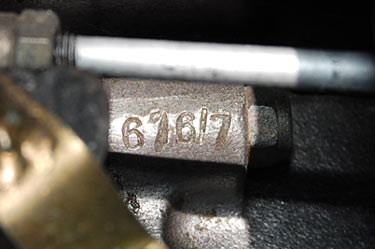
|
Click on any of the above images for a full-size view
Details: one of the mighty Super 90 Solex 40 PII-4 carbs with twin trumpets, ultra-rare Mallory 6-Volt high performance coil, and engine case number.
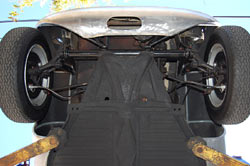
|
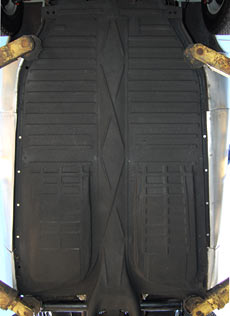
|
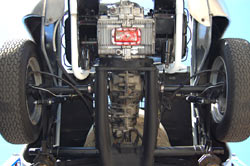
|
Click on any of the above images for a full-size view

Click on the above image for an XXL-sized view (a separate browser window will open)
Now let's go and have some fun in our unique '53 Fahrmaschine !
Unreal! Time warp! Scary fast! -- those were some of the excited statements upon our first drive after the car's resurrection. The Spyder starts without fuss and, after being warmed up for a minute, idles nicely. Even at low engine speeds, the colorful music emanating from the racing muffler combined with the rushing sound of the air sucked into the carb stacks, will make the hair on the back of your neck stand up. It's the true sound of a vintage race car, barely tamed for street use. No wonder the Baron stated that he parked the car because it was too fast for him!
It's a vehicle that demands 100% of your attention, 100% of the time. Shifting, braking, steering: everything functions smoothly; once you have explored the car's adhesion limit (best done at a race track, not on the street!), you will be able to rapidly pilot this 10-pounds-per-horsepower road rocket past any number of larger and heavier vintage racers.
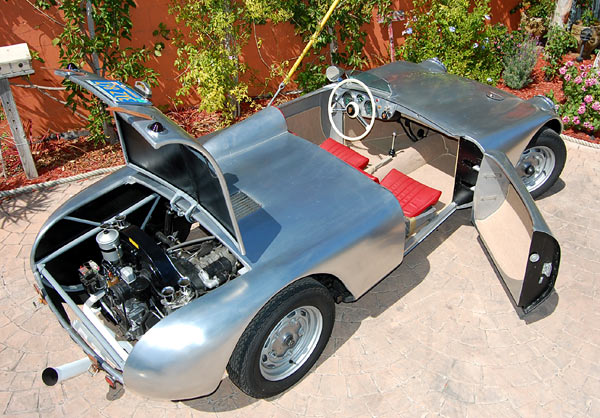
Click on the above image for an XXL-sized view (a separate browser window will open)
Returning home, we still marvel at the Spyder's performance. Such a lovingly finished, potent car, it makes you wonder how it would have fared at the big road races of the day. But, don't fret, this car will be able to secure invites for the most prestigious events, its second lease on life having just begun!
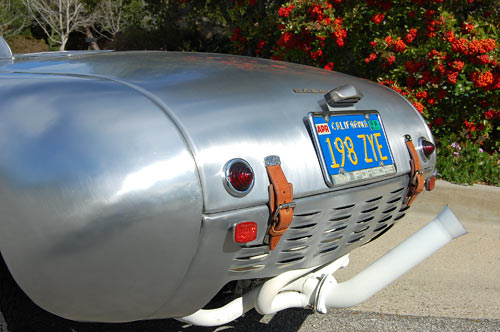
Click on the above image for an XXL-sized view (a separate browser window will open)
Here it is, in all its silver glory, perhaps the last and best Porsche-derived 1950s alloy special not yet tucked away into a museum or private collection. It's available today at a fraction of the cost of a factory-built Spyder; with the help of the Internet, its early competition history is bound to be uncovered any day, just the way it happened with the Baron's other alloy stowaway, the Baldwin. Certainly, apart from its outrageously captivating look, sound, and performance, the Spyder's appreciation potential is astronomical!
Addendum:
We sold this amazing Spyder in June of 2011.
Back to Californiaclassix' Hall of Fame or Home.
